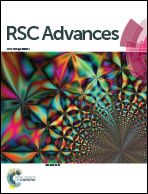Fabrication of a flexible copper pattern based on a sub-micro copper paste by a low temperature plasma technique†
Abstract
Flexible devices have attracted much attention due to their great potential as next-generation electronics and for their applications in healthcare, fitness and AI robots. In these devices, the circuits composed of printed metal pastes are regarded as the key components on various flexible substrates. Although low temperature silver (Ag) paste has been applied in these devices, a high price and electromigration seriously limit their wide application. Copper (Cu), which has almost the same conductivity but is low cost and electromigration-resistant has been expected to be a substitute for the Ag-based paste. Herein, sub-micro copper particles with a suitable diameter were synthesized by a simple large-scale polyol method. A Cu paste was further formed from the Cu particles and printed onto a flexible substrate to form a Cu-based pattern. A reactive plasma process was used to sinter the copper pattern at low temperature. A high conductivity Cu pattern with a resistivity of 15.9 μΩ cm has been successfully fabricated with only 10 minutes sintering at 200 W due to an enhanced plasma effect. The temperature was below 75 °C during the plasma process. A V-shape Cu antenna pattern has also been arranged on PET to fabricate a flexible antenna device, and the results show that the pattern has the same sensitivity for high-frequency signals when compared to bulk commercial copper foil.


 Please wait while we load your content...
Please wait while we load your content...